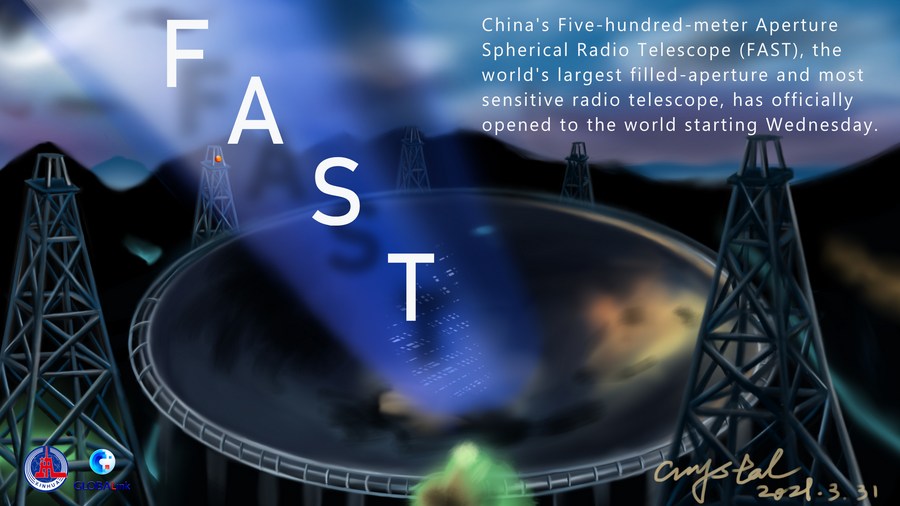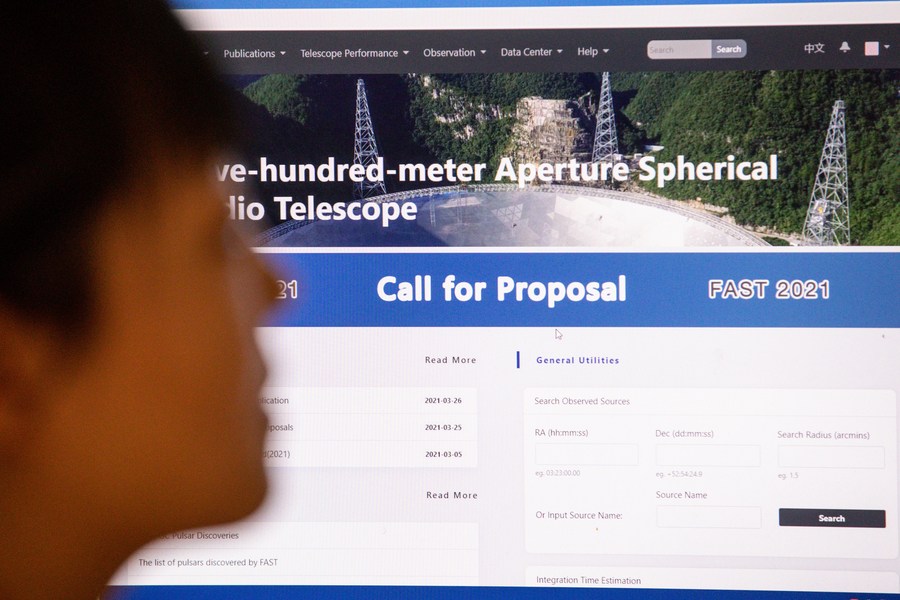-- China's Five-hundred-meter Aperture Spherical Radio Telescope (FAST), the world's largest filled-aperture and most sensitive radio telescope, has officially opened to the world starting Wednesday.
-- Astronomers globally can submit their observation applications for evaluation till May 15 and the results will be announced on July 20. Observations by overseas scientists will begin in August.
-- The opening of FAST demonstrates that China is seriously expanding the circle of friends in basic research and sharing FAST with the rest of the world, said Li Di, chief scientist of the telescope.
by Xinhua writers Cao Bin, Qi Jian and Liu Xinyu
GUIYANG, March 31 (Xinhua) -- China's Five-hundred-meter Aperture Spherical Radio Telescope (FAST), the world's largest filled-aperture and most sensitive radio telescope, has officially opened to the world starting Wednesday.

Experts expect the gigantic telescope to bolster global astronomical research and find answers to some of the biggest unknowns in modern astrophysics and cosmology.
Astronomers globally can submit their observation applications for evaluation till May 15 and the results will be announced on July 20, according to a statement by the National Astronomical Observatories (NAO) under the Chinese Academy of Sciences (CAS). Observations by overseas scientists will begin in August.
About 10 percent of FAST's observation time in the first year, roughly 450 hours, is expected to be allocated to foreign scientists, said Li Di, chief scientist of the telescope and a researcher with the NAO.

Many global astronomers have been looking forward to the opening of FAST following the collapse of the 305-meter vast telescope at Arecibo Observatory in Puerto Rico last December. The competition for grabbing observation time is set to be fierce, Li said.
Wu Xiangping, an academician with the CAS and director of FAST's science committee, said the applications submitted by domestic and overseas scientists will be evaluated by top international experts in their respective fields to ensure that the approved applications are in line with scientific frontiers.
The competition for observation time among Chinese scientists has already been very intense. During its trial run in 2019, FAST planned to operate for 360 hours but ended up receiving more than 2,000 hours of observation applications. In 2020, only about 30 percent of applications were approved.
Pre-research on the FAST project started in 1994 and its construction was completed in September 2016. It began formal operations in January 2020 after more than three years of test runs. Since then, the telescope has provided stable and reliable services.

As the world's most sensitive radio telescope, FAST, based on observables between 70 MHz and 3 GHz, is over 2.5 times more sensitive than Arecibo. According to the sensitivity calculation by astronomers, it can effectively explore four times more the scope of the universe space compared to Arecibo, greatly expanding the human observation of the universe.
To date, FAST has found more than 300 pulsars, and the number is expected to reach 1,000 in the next five years. It also made breakthroughs in fields like fast radio bursts, a type of powerful radio wave.
Chinese scientists are already using FAST to track Andromeda, the nearest galaxy, where they hope to find the first extragalactic pulsar.

The opening of FAST demonstrates that China is seriously expanding the circle of friends in basic research and sharing FAST with the rest of the world, Li said.
"Before FAST was put into use, China's radio telescopes usually had a diameter of less than 50 meters," said Wang Qiming, FAST's chief technologist. "FAST marks a huge leap forward."
FAST's operation and maintenance team is working to fine-tune algorithms and upgrade software systems to further improve its observation efficiency and meet the growing demand from the international astronomical community.

Every small improvement in FAST's hardware and software is essential as the project team seeks to maintain the telescope's leading position in the high-competitive radio astronomy field, said Yan Jun, former head of the NAO and manager of the FAST project.
Meanwhile, Li noted that astronomy is an open discipline, and many early achievements of FAST involve international experts. With the opening of FAST, foreign scientists can lead some research projects independently or act as chief experts.
The FAST project has also teamed up with observatories and astronomical teams worldwide including the American Laser Interferometer Gravitational-Wave Observatory to support frontier scientific research.
On the other hand, some potential exploratory projects led by young scientists globally will be given special support in the allocation of observation time. Such projects include research on the detection of fast radio bursts and radio detection of exoplanets, among others, Li added.
(Video editor: Wei Yin; video reporter: Liu Qinbing, Yang Yanbin, Ou Dongqu, Ou Dongqu and Chen Qiang.)


















